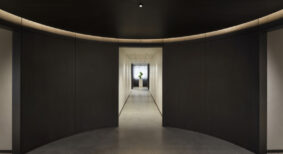The profession of interior design in British Columbia has been self-regulated since the inception of the Interior Designers Institute of British Columbia (IDIBC) in 1950. IDIBC continues to flourish, with more than 800 registrants constituting the second largest professional interior design association in Canada. Our mandate is clear – to serve and protect the public interest in British Columbia by overseeing best practices in the governance, administration, enforcement, and continuing education of IDIBC registrants.
In B.C., registrants of IDIBC can only obtain professional status and earn the title of Registered Interior Designer (RID) by holding a baccalaureate degree from an accredited post- secondary interior design program; successfully completing a mandatory set of North American recognized examinations; an intern period under the full-time supervision of a RID; being a registrant in good standing through compliance, continuing education; and upholding best practices with IDIBC oversight.
Although the profession is relatively youthful when compared to architecture and engineering, interior design is a vital component of almost any building. Today’s structures are more complex than ever, demanding an increasing degree of specialization. RIDs in British Columbia play an important role in the design and construction of buildings, working in collaboration with architects, engineers, landscape architects and other allied professionals associated with the built environment.
In B.C., legislative involvement is needed to further provide public protection by recognizing and regulating individuals who have the education, work experience and ethics worthy of practicing as a qualified interior design professional. Such legislation is generally in the form of a statute that protects established titles and reserved practice for each profession. In Canada, Nova Scotia, New Brunswick, and Alberta have designated practice acts for the profession of interior design that are overseen by each provincial government.
IDIBC has been actively seeking title designation and protection of the interior design profession through legislative change since 2012. A Government Regulatory Committee was created in 2013 to help establish, develop, and maintain relationships with key government stakeholders and associated built environment regulatory bodies. Over the past decade, IDIBC has made significant progress in building awareness of our registrants to better protect the public interest through best practices, while shifting from being a self-regulated body with no government oversight to taking proactive steps in anticipation of transitioning into a regulatory body with a government protected title designation.
A major component of this anticipated change in structure was recognizing the need to get our house in order and to effectively support IDIBC registrants. A restructuring of IDIBC over the last four years has resulted in a stronger, highly organized, and comprehensive regulatory body. Advocacy roles that were previously part of the mandate of IDIBC are now housed by regional societies that continue to champion the profession of interior design throughout B.C.
As provincial and state jurisdictions across North America continue to assess and provide title protections and regulation of the profession of interior design, the B.C. government has recently formed an umbrella act that would be an appropriate regulatory framework for interior design.
The provincial government identified a need to focus on regulatory bodies that incorporate professional reliance in professions dealing with the built environment and the natural resource sector. Following a professional reliance review of such in 2018, the Professional Governance Act (PGA) took effect in February 2021. The purpose of the PGA is to develop a governance framework that follows international best practices and to help regulatory bodies strengthen their role in protecting the public interest while improving public trust in professionals.
There are currently six professional regulatory bodies named in the PGA, including the Architectural Institute of British Columbia (AIBC), and Engineers and Geoscientists British Columbia (EGBC). More professions have since submitted application to the administrator of the PGA, the Office of the Superintendent of Professional Governance (OSPG), to request designation or to seek regulation of their profession. The Superintendent of Professional Governance has recently recommended the British Columbia Society of Landscape Architects (BCSLA) and the profession of Landscape Architecture to be designated under the PGA.
IDIBC is in the final stages of preparing an application to the OSPG requesting designation of the institute and the profession of interior design under the PGA. A Government Relations Committee was struck in 2020 to focus primarily on developing the application with the IDIBC executive director. A legislative consultant was engaged in 2023 to assist in producing a draft of the application document. After an extended period of hard work and due diligence, IDIBC is on schedule to apply to the OSPG this spring for designation under the PGA.
IDIBC is hopeful that the B.C. government will recognize and act on inclusion of our profession under the PGA. Legislative change resulting in a government statute for IDIBC and the interior design profession will allow RIDs to work to their fullest capability. Title protection will help RIDs become true registered professionals and reduce red tape by streamlining building regulatory processes in B.C.
Work that RIDs are qualified to practice in other provincial jurisdictions with designated interior design title protection but disallowed in B.C. without the involvement of a registered professional is a redundant cost burden to the public, and a detriment to RIDs. Title protection will also further protect the public by enabling enforcement of non-qualified individuals who practice illegally.
The time is ripe for IDIBC and the profession of interior design in B.C. to become part of a government regulatory framework that benefits all British Columbians.
Jim Toy, BA BArch LEED AP RID (Fellow), is president of the Interior Designers Institute of British Columbia. He is principal of False Creek Design Group Ltd.







